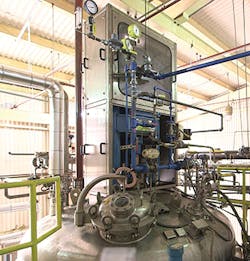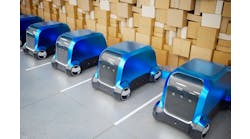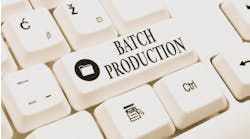Hey, Jack, how many trades can you master? Just as the decathlon is the ultimate test in track and field, and customization recently joined mass production, batch processing is being challenged to increase its flexibility and modularity to tackle increasingly complex projects and processes.
Perhaps a partial victim of its own success, the ANSI/ISA-88 batch process control standard and its concepts, principles and even its language have been adopted by many other applications and industries, some only tenuously related to batch. And now, thanks to their growing popularity, many batch methods are being drawn into all kinds of new tasks and applications they've never faced before from automating formerly manual dosing processes to interacting with high-level documentation, enterprise and cloud-computing systems. Fortunately, more than a few developers, system integrators and other innovators are devising solutions such as add-on software and components that can give batch applications the additional configurability and capabilities their users require.
"Our life sciences and liquids clients stick to the ISA-88 model for batching because it's been available for many years and everyone knows its terminology such as 'phases, equipment units and control modules,' " says Bryon Hayes, life sciences director at system integrator and business consultant Grantek, which is a certified member of the Control System Integrators Association (CSIA) with offices in the United States and Canada. "However, users always want more from their production processes, so they use traditional, monolithic, single-server batch software based on 30-year-old code base to scale up from pilots or single products made in one process cell. This makes it easier to adjust batch parameters when raw materials are different or other conditions change."
Rusty Bailey, branch manager in the Memphis, Tenn., office of CSIA-certified system integrator Bachelor Controls Inc. (BCI), adds that, "Clients making modified starches typically use a process that's similar to specialty chemicals manufacturing. They need to make adjustments based on the pH of ingredients, change temperatures and prepare for the next starch product that may need a different sequence. With ISA-88, they don't need to write new code; they just need to adjust their existing models.
"Of course, different users employ different ISA-88 models, but lately they're getting more agile in responding to market demands and adjusting their sequences to meet those demands. ISA-88 makes it easier for users to go back and alter their sequences without going back to the system integrator or software developer. Also, while many bulk ingredient processes are automated, users also want to automate adding costly micro-amounts of ingredients that were previously done manually, and go to more electronic record-keeping for better tracking and tracing."
Software and simulation
Figure 1: To produce more and increasingly varied products in small quantities to exacting specifications, Jayhawk Fine Chemicals relies on Siemens Simatic PCS7 DCS with add-on Simatic Batch software to plan, configure, automate, control and log its processes directly in the DCS.
While recent innovations in batch software, support technologies and even ISA-88 itself are relatively new, their shared quest is old—to produce better batches of consistent, higher-quality products. Not surprisingly, this is also the bread-and-butter mission at Jayhawk Fine Chemicals Corp. in Galena, Kan., which is part of Germany-based CABB Group GmbH, and recently worked with Siemens Industry Inc. to optimize batch production of thermoset additives such as dianhydrides and crosslinkers, pharma-starting materials and high-purity solvents. Its flagship dianhydride is BTDA, which is used as an epoxy thermal curative and a building block for polyimide synthesis. Jayhawk typically produces these products in limited quantities to exacting specifications, but it's also facing increasing and increasingly unique jobs that vary widely in size and scope. Its multi-step batch processes require constant pivoting between products recipes and campaigns, so it's come to rely on Siemens Simatic PCS7 distributed control system (DCS) that recently added Simatic Batch add-on software, which lets Jayhawk plan, configure, automate, control and log its processes directly in the DCS (Figure 1).
"We use PCS 7 to automate formerly manual steps, so they no longer require user input, which helps our operators focus on steps where their attention is most critical,” says Damon Culp, instrumentation and controls engineer at Jayhawk. "PCS 7 gives them all the process information they need including prompts and alarms to make the best possible decisions in the control room or the field.”
PCS 7 with Simatic Batch presently serves in four of Jayhawk's onsite operating units, including one that fully meets good manufacturing practice (cGMP) validation requirements. The company also decided to virtualize systems in two units with Simatic Virtualization as a Service (SiVaaS), which is a preconfigured, ready-to-run virtualization package that preloads VMWare and PCS 7 components on Jayhawk's new HP computing platform. Two virtual servers host thin clients to provide redundancy protection, reduce costs and simplify maintenance. Jayhawk also uses Siemens' Simit simulation platform that works closely with PCS 7 for virtual commissioning and operator training. Simit lets users test new control strategies, including sequences, and make changes before deployment. This lets operators practice all new procedures in Simit, ensuring they’re carried out correctly once online.
Jayhawk reports it previously used Siemens' APACS+ DCS with Wonderware SCADA/HMI that required configuration in both environments to link and visualize Simatic Batch software. PCS 7 with Simatic Batch is simpler because it's a single-vendor, integrated solution that works from one database, and automatically creates visualization, navigation and reporting elements. “Before upgrading to PCS 7, we experienced very good process control with APACS+," says John Gaines, business engineering manager at Jayhawk. "However, just by installing PCS 7 with Simatic Batch and doing nothing else, we saw a 5% increase in overall equipment effectiveness (OEE)." These OEE gains were achieved through shortened cycle times due to increased automation that reduced gaps in time between steps, added prompts when operator actions are required, clearer system dialog about what's expected, and improved visualization of exactly where the operator is in the process and what still needs to be satisfied, which is also true for interlock and alarm management.
Larry Mosier, site operations manager at Jayhawk, adds, “There are multiple processes where PCS 7 provides guidance to operators and prompts them when specific tasks are complete. In some cases, it even asks for input regarding what analysis was shared from our laboratory before giving the operator a green light to advance to the next step.”
Points from all sides
Beyond gaining flexible capabilities and emerging in diverse applications, ISA-99 batch is also being applied in far larger and more complex applications. For example, ACG Flat Glass North America Inc. has used OSIsoft's PI Historian software for about 25 years to help it make float glass, which melts silica in a furnace before forming it on a bath of molten tin. However, in the wake of recent furnace rebuilds at its three U.S. plants in Church Hill, Tenn.; Spring Hill, Kan.; and Richmond, Ky., it began to seek control and historian upgrades, and ways it could use big data, machine learning (ML) and artificial intelligence (AI).
Each of its four furnaces (two are in Church Hill) can melt 600 tons of glass per day to make glass rectangles up to 130 x 240 in., but after 15-20 years, their refractory bricks erode away, necessitating a rebuild. The plants also include lehr ovens for annealing, where controlled cooldowns let AGC create stress points in predictable areas. They also add pyrolytic coatings based on required product profiles. These processes require 1,500-1,600 data points at Church Hill and Richmond, mostly in the float area, while Spring Hill has 6,000 data points. They gather data about thermocouple temperatures, natural gas flows and differential pressures, weights on load cells, and from cameras monitoring glass thickness. All this data goes to PI from OSIsoft and to ControlLogix PLCs and PlantPAx DCS from Rockwell Automation.
"Our executive team asked us to begin looking at how we could use big data a couple of years ago. We'd always used PI Historian, but now our warehouse is using PI Vision software to verify storage and optimize pick-and-place operations, so we began to use the new Event Frames dashboard in the PI System's Asset Framework contextualization layer along with our real-time data to better document and optimize our glass manufacturing," says Bradley Willson, electrical engineer at ACG. "We started using Event Frames for looking at power usage to try and avoid some time-of-day charges by creating analytics to predict demand for interval windows. If we could see that electricity price increases were happening in certain timeframes, we could notify the engineers to switch to redundant fans or take other actions, avoid some large fees, and save a couple percentage points on our annual power costs."
Willson reports this is very basic ML with a small dataset, but it does occur in real-time by running an algorithm in PI Asset Framework. "It informs operators and supervisors via email that a costly window for electricity is coming up, and that they're close to an expensive decision that could increase our utility bill. Before deploying this tool, we worked with our engineers and operators, and they were OK with these advisories as long as we weren't automatically turning equipment on or off. They initially considered it too risky at the beginning of this new process."
Willson adds that ACG is also looking at using PI System and its large archive of historical data to trace product defects back to process events, correlate information with results, and use them to identify significant trends in upcoming 24/7 operations and data collections. "Humans can't check processes 24/7, so we need machine learning to help us connect the dots," says Willson. "PI is also powerful because it lets us compress 30 years of archived data, focus on what's meaningful, find trends, and do sanity tests. For instance, if we're looking at a trend that's been stable and then suddenly spikes, we can quickly determine if it was a special cause and reset it. An example of this behavior is caused by a thermocouple failing in the furnace."
Enrique Herrera, industry principal for manufacturing and connected services at OSIsoft, adds, "We're usually seen as a company collecting data that users can react to, but there's a growing appetite for information and sophisticated analytics that can be used for more proactive troubleshooting and optimization. So, we developed Event Frames to examine data continuously and send alerts. PI always had the ability to do things like mark the beginnings and ends of batches and send notifications, but now we're adding functions organizing by frames, shaping data with sophisticated analytics, marking digital snapshots to find when predefined conditions have been met, and overlaying snapshots to make long-term comparisons."
Figure 2: BCI Core software application from Bachelor Controls is layered on top of a mainstream batching engine, which provides the ISA-88 batching structure, while BCI Core maintains an ingredient library, recipe formulations, storage locations, in-process inventory and other capabilities, such as building batch campaigns and organizing or reorganizing schedules and work orders.
Modularity mobilizes
To achieve the automation and agility that batch users are seeking, and help machine builders deliver more flexible batching equipment and software, BCI has developed its BCI Core software application that provides a high level of configurability, user-friendly interface, and improved interaction with ERP systems (Figure 2). It's layered on top of a mainstream batching engine such as Rockwell Automation’s FactoryTalk (FT) Batch software, which provides the ISA-88 batching structure, while BCI Core maintains an ingredient library, recipe formulations, storage locations, in-process inventory and other features, such as building batch campaigns and organizing or reorganizing schedules and work orders.
"Many operators say they can only run one batch at a time and can't line up jobs because each usually needs some custom configuration," explains Bailey. "BCI has been doing data and server interfacing since 1994, and a year later, developed add-on instructions for automated batch scheduling in the BCI Batch Engine, which was originally written in Visual Basic. We did a full rewrite in C# to develop BCI Core in 2017, but it's based on many years of history. We also standardized its core software that's reusable and gets rid of undocumented features, which let users customize and employ what item types they need, such as ingredients, mix and cook times, or anything else. They can even add rest times for a formula, write them into the ISA-88 procedure for a recipe, and pull it from their core SQL serve database later. We've done this for years, but users often aren't as aware about what's available. BCI Core lets them take advantage of these object models and use them repeatedly."
Bailey adds that 80-85% of batch applications have the potential to reuse their code, which can jointly reduce commissioning times and get solutions to customers 30-50% faster. "BCI Core also captures production information, and adds it to a database," he says. "This is part of its version control and reporting functions, so if a recipe is modified or a formula is adjusted, it will retain both the old and new versions."
Similarly, Grantek's Hayes adds, "We're also seeing clients that want to further digitalize their electronic batch records (EBR), incorporate content-rich and annotated work instructions for operators, and connect the quality assurance (QA) department to make it possible to release batches by exception in one or two days, instead of several weeks. Digitalization is also blurring the lines between DCSs and PLCs, so batch software is becoming less monolithic, more modular and more closely integrated with controls."
For instance, Hayes reports that tools such as Rockwell Automation's Logix Batch and Sequence Manager (LBSM) are moving some batch functionality into controllers, including adding batch visualization to SCADA systems, performing batch control at the PLC level, and moving equipment marshalling from former monolithic software to modules at the controller level. "Digital EBRs solve paper batch record problems, such as verifying the use of the correct master batch record, and documenting weights and dispensed materials to comply with regulations," says Hayes. "Likewise, Werum's PAS-X pharma-specific MES software does material management, but the benefit is it also performs EBR functions."
Hayes explains that Grantek recently used LBSM software on a lower-margin nutraceuticals project to give the client recipes that could be nimbly adjusted and optimized, instead of implementing either difficult-to-maintain recipes in ladder logic or costly, monolithic batch software. "LBSM operates a controller-based execution paradigm that runs in the PLC firmware, while ISA-88 phases programmed in the controller code act as an intermediary between the recipe and the production equipment," he says. "In regular batch software, when the recipe says 'mix,' a phase logic interface (PLI) routine takes the instruction and passes it to the equipment module. PLI confirms the instruction was sent, and the phase status is passed back up. It's like a handshake between phase logic and batch execution. The difference with Rockwell's solution is now we can have both phases and recipes inside the PLC with logic and routines, with the PLI hidden in the firmware. This is what gives our nutraceutical client flexible recipes, which can make phase logic and parameter adjustments without having to go in and change lots of PLC code."
Hayes adds these logic phases can be reused. This means users no longer need to put multiple routines back together for a mixing phase, and can just redeploy the code they used before. "This makes code reuse easier because users can establish code libraries that are almost built-in, so less customization is needed, programming can be more modular and less costly, and batch records are easier to document," adds Hayes. "For example, LBSM is a sub-set of Rockwell’s PlantPAX platform, which has a library of process objects that make it easier for users to design and program applications. Instead of writing code from scratch, they can simply add software objects for valves or other equipment types, actuation functions, configurations, control loops or alarms. This is another way that PLCs and DCSs are becoming more like each other because users don't have to create their control modules in ladder logic."








